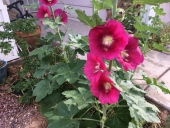





 2
2




Some places need to be wild
 1
1




Eric Hanson wrote:Ben,
For my 2 cents, I like the idea of drying to death, but I would suggest doing it in a tub or something so that if the there is just one plant that aren’t 100% completely dead, regrowth won’t take over the garden bed.
I would want to make certain that ... she's not only merely dead, she's really most sincerely dead.
Eric
A build too cool to miss:Mike's GreenhouseA great example:Joseph's Garden
All the soil info you'll ever need:
Redhawk's excellent soil-building series





 2
2


















Some places need to be wild




 1
1




Trace Oswald wrote:
Eric Hanson wrote:Ben,
For my 2 cents, I like the idea of drying to death, but I would suggest doing it in a tub or something so that if the there is just one plant that aren’t 100% completely dead, regrowth won’t take over the garden bed.
I would want to make certain that ... she's not only merely dead, she's really most sincerely dead.
Eric
Fixed that for you. Sing in your favorite Munchkin voice...




 2
2




Greetings from Brambly Ridge
 1
1








yes it’s an uphill battle... but it does keep the soil niceRuth Meyers wrote:I've been fighting Japanese honeysuckle for nearly a decade. I'll never win because it had such a head start and covers a lot of my woods edges and open bramble land. But I can vouch for the fact that clippings don't re-root. The roots can be pulled up to some extent and they also just dry out and die. I chop and drop and it's obvious where I've worked.




William Bronson wrote:I presume you don't keep animals, or at least not enough of r the right kind to munch their way through the clippings.
If I was going to go as far as to use fire , I think I would make them into biochar.
A trench could be dug right near where they grow, and after quenching, filled back in.
 1
1




It's time to get positive about negative thinking  -Art Donnelly
-Art Donnelly

|
She said she got a brazillian. I think owning people is wrong. That is how I learned ... tiny ad:
Homestead Pigs Course
https://permies.com/wiki/365748/Homestead-Pigs
|


